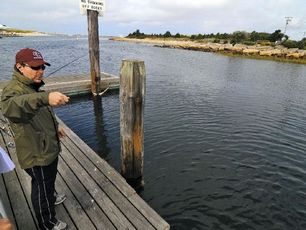
October 2, 2008
Paul Spear says he knew right away he saw a manatee in Sesuit Harbor, Massachusetts, on October 1, 2008, because the tail was too broad and large to be a seal. Photo: Cape Cod Times/Steve Heaslip
Cryptomundo field correspondent Elizabeth Livada sends along this report from Cape Cod.
The sighting does make one wonder if a minority of ancient Merbeing, Sea Serpent and/or Sea Monster encounters in New England may have been incredibly out-of-place manatees.
Of course, too, we have to love any account with a marine cryptid that uses a headline like this one: “Dennis Manatee: ‘It’s Like Seeing Bigfoot.'”
Paul Spear thought he was seeing things. Standing on the dock with his 8-year-old son Kevin and friend Frank Rothwell, jigging for small fish, he thought he saw a large piece of the Sesuit Harbor bottom move.
“I thought for an instant the ground was moving,” Spear said.“It looked like a giant ball of seaweed,” Kevin Spear added.
Rothwell and the Spears watched in amazement as a moss- and algae-covered 5- to 7-foot long animal slowly moved past them, within reach of their fishing poles, in just 3 feet of water, and headed out of the harbor with the outgoing tide.
It was moving too slowly and the tail was too broad and large to be a seal, said Paul Spear. He and Rothwell knew right away what it was: a manatee, a tropical species rarely found north of Florida, and never found in Cape Cod Bay.
“It’s like telling someone you saw Bigfoot,” Paul Spear said of the skepticism he expected when telling people what they’d seen.
“I know what a seal looks like, and the head looked totally different,” said Rothwell, a vice principal at a Framingham High School. Spear is the work/study coordinator at the school and coaches the hockey team.
But the two found a sympathetic ear in Erin Burke, an aquatic biologist with the state Division of Marine Fisheries. Burke handles protected species, and the manatee, with approximately 3,000 in U.S. waters, is listed as a federally endangered and protected species.
Burke believed the men’s report was a credible sighting and that this manatee might be the same one that was seen in the Taunton River in Fall River Sept. 18. A manatee was last seen in Cape Cod waters in August 2006, and Dennis is the farthest north any manatee has ever been seen before. [This one and only other verified sighting of a manatee this far north, in 2006, was of a 1,000-pound manatee spotted in Quissett Harbor, Falmouth, Massachusetts. – LC]
“I’m aware of those sightings, and we believe they are credible,” said Cathy Langtimm, a United States Geological Survey wildlife biologist working with manatees in Gainesville, Fla. Langtimm confirmed that Dennis marked the northernmost sighting.
“It must have gone through the canal,” said Burke. She was concerned that, with water temperatures at 61 degrees yesterday, the manatee might end up stranding. She asked for the assistance of Cape harbor masters and the state environmental police to patrol the shore and shallow waters to locate the animal.
Langtimm said manatees tend to head south when waters dip below 68 degrees. Those who venture up into northern waters tend to be males who are simply exploring, continuing northward as long as there is plentiful sea grass and other vegetation to graze on. Typically, they remain in shallow waters, less than 30 feet deep. They also need to drink fresh water and will seek out culverts, storm drains, and other freshwater outlets along shore.
“They can handle cooler water for short periods of time,” said Langtimm, but sometimes they become trapped by a cold snap and can die.
Burke asked that if anyone spots the manatee they take a photo, focusing in on distinctive scarring on their backs and tail, that are made when they are hit by boats. Researchers in Florida can match these scars to a catalog of photos that helps them identify the individual.
The Massachusetts Environmental Police will be looking for the animal today in and around Cape Cod Bay, said Capt. Peter Hanlon.
State officials believe it is a manatee that has been known to come up to Rhode Island, Hanlon said. Because of the dangers posed to the animal by the cold water, anyone who spots it should call the Cape Cod Stranding Network at 508-743-9548, Hanlon said.
For more background species information and their manatee quiz, see the complete source, “Dennis Manatee: ‘It’s Like Seeing Bigfoot,'” by Doug Fraser, Cape Cod Times, October 02, 2008.
About Loren Coleman
Loren Coleman is one of the world’s leading cryptozoologists, some say “the” leading living cryptozoologist. Certainly, he is acknowledged as the current living American researcher and writer who has most popularized cryptozoology in the late 20th and early 21st centuries.
Starting his fieldwork and investigations in 1960, after traveling and trekking extensively in pursuit of cryptozoological mysteries, Coleman began writing to share his experiences in 1969. An honorary member of Ivan T. Sanderson’s Society for the Investigation of the Unexplained in the 1970s, Coleman has been bestowed with similar honorary memberships of the North Idaho College Cryptozoology Club in 1983, and in subsequent years, that of the British Columbia Scientific Cryptozoology Club, CryptoSafari International, and other international organizations. He was also a Life Member and Benefactor of the International Society of Cryptozoology (now-defunct).
Loren Coleman’s daily blog, as a member of the Cryptomundo Team, served as an ongoing avenue of communication for the ever-growing body of cryptozoo news from 2005 through 2013. He returned as an infrequent contributor beginning Halloween week of 2015.
Coleman is the founder in 2003, and current director of the International Cryptozoology Museum in Portland, Maine.
Filed under Breaking News, Cryptomundo Exclusive, Cryptotourism, CryptoZoo News, Cryptozoology, Eyewitness Accounts, Merbeings, Out of Place, Sea Serpents